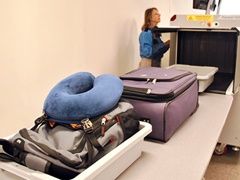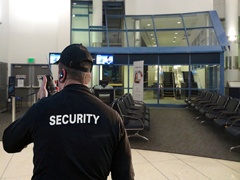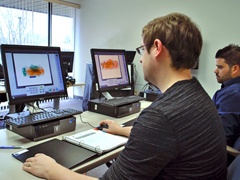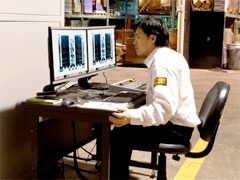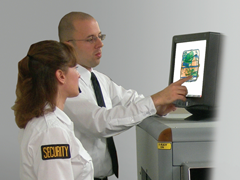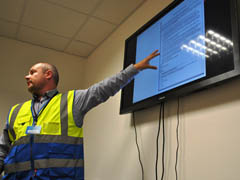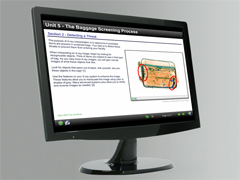The abundance and variety of items passing through a security checkpoint is overwhelming. Yet X-ray screeners are under immense pressure to examine all goods with speed and accuracy. This can be a difficult task considering throughput could be any combination of items imaginable.
In order for X-ray screeners to be successful on the job, they must constantly be exposed to different items under X-ray. Continuous practice is absolutely necessary to introduce new material to build upon a screener’s mental image library and keep the mind sharp.
Read More
Topics:
Security Training,
Training & Development
A new year means another year of security training. The thought of recurrent training usually re-enters the minds of training managers and administrators at this time of year. Sometimes seen as an overwhelming process, the anticipation of rolling out another year of security training to personnel can be stressful.
It’s not always easy to coordinate but if you know the basics and have the right tools, it can be much easier than anticipated. And when the time comes, you’ll be able to handle a compliance audit like a pro. First, let’s get down to discussing the basics of recurrent security training.
Read More
Topics:
Audit Preparation & Compliance,
Security Training,
Aviation Security,
Training & Development,
Cargo Security
What does it mean to have strong aviation security culture? A strong aviation security culture is one in which security is a top priority for all staff. It means that security can never rest at the back of our minds; it must constantly be at the forefront. It also means that security cannot be an afterthought; it must be approached with a proactive mindset.
If we lose sight of the importance of aviation security for a moment, we risk becoming vulnerable to the imminent dangers that constantly pressure our industry. Security is everybody’s business. So, what can you do to build a strong aviation security culture within your company?
Read More
Topics:
Security Training,
Aviation Security,
Training & Development,
Cargo Security
Many companies rely on X-ray systems to screen items arriving at or passing through their facility. The items these security screeners typically observe varies depending on the industry and whether belongings, cargo, or mail are being screened. For instance, screeners inspecting visitor belongings at a courthouse would experience different throughput than those inspecting passenger luggage at an airport.
Because of this, some companies would prefer to customize simulator training by adding their own X-ray images. To do that, an image capture is required. Here are some best practices for conducting your own in-house X-ray image capture.
Read More
Topics:
Training & Development,
Ports & Borders,
Critical Infrastructure,
Transportation
For security screeners, being able to identify threats and prohibited items under X-ray is an important responsibility. To aid in this task, some may agree that learning how to identify everyday objects is almost equally important since most items inspected are innocent. Think about it. How beneficial would it be for security screeners to recognize and clear innocent everyday items quickly and efficiently? A rapid check over of the X-ray image is all it would take for a skilled screener. That’s why practice recognizing everyday objects alongside threats and prohibited articles is encouraged.
Read More
Topics:
Security Training,
Aviation Security,
Training & Development,
General Security,
Cargo Security,
Ports & Borders,
Critical Infrastructure,
Transportation
X-ray systems are deployed at security checkpoints in many different industries. X-ray operators use them to screen belongings, mail, and cargo. In real-time, these operators must be able to view an X-ray image and promptly make a decision about it - whether the scanned items are safe to proceed or if further inspection is required.
To get to that point, there are a few fundamental topics X-ray operators must have a solid understanding of first. Help operators become successful at X-ray screening on the job by ensuring your X-ray equipment training includes these critical topics.
Read More
Topics:
Security Training,
Aviation Security,
Training & Development,
General Security,
Cargo Security,
Ports & Borders,
Critical Infrastructure,
Transportation
In the aviation security world, conventional X-ray systems are still the dominant technology used to screen baggage and cargo. The technology is proven, stable, and holds up well to the operational demands of an airport. However, one of the biggest challenges for screeners is trying to interpret what’s inside a passenger’s baggage using a ‘flat’ or two-dimensional (2D) image.
As three-dimensional (3D) X-ray systems continue to improve, we can expect more of them to be widely deployed at airports. Meanwhile, X-ray screeners will have to learn how to shift from 2D to 3D X-ray interpretation.
Read More
Topics:
Aviation Security,
Trends,
Training & Development
Workplace supervisors have day-to-day responsibilities they must attend to including overseeing employees, ensuring productivity is maintained, and reporting to management. Part of their duty involves coaching employees, but sometimes that role expands into a full-on trainer position.
Many companies experience this – supervisors are forced to take on additional responsibilities in order to provide employees with security training in compliance with regulations or programs such as EU 185/2010, AOSSP, IACSSP, FACAOSSP, MSP, or CCSP. When supervisors double as security trainers, they’re only fulfilling a short term role so supervisors generally do not get the guidance and support needed to be successful in delivering training.
Read More
Topics:
Security Training,
Aviation Security,
Training & Development,
General Security,
Cargo Security
Many companies in the transportation, critical infrastructure, and ports & borders market require some form of security training. This could be to ensure safe transit systems for passengers, secure chain of custody for cargo, detect threats at security checkpoints, or prevent the smuggling of prohibited items across borders.
Whatever it may be – the trend for security training to progress along with our rapidly expanding use of technology is only natural. That’s why more and more companies are comfortable turning to Computer Based Training (CBT) to fulfill their security training needs – using it alongside Instructor Led Training (ILT) or replacing it altogether.
Let’s explore nine reasons why CBT has become increasingly popular over traditional classroom instruction in the training industry.
Read More
Topics:
Training & Development,
Computer Based Training (CBT)

